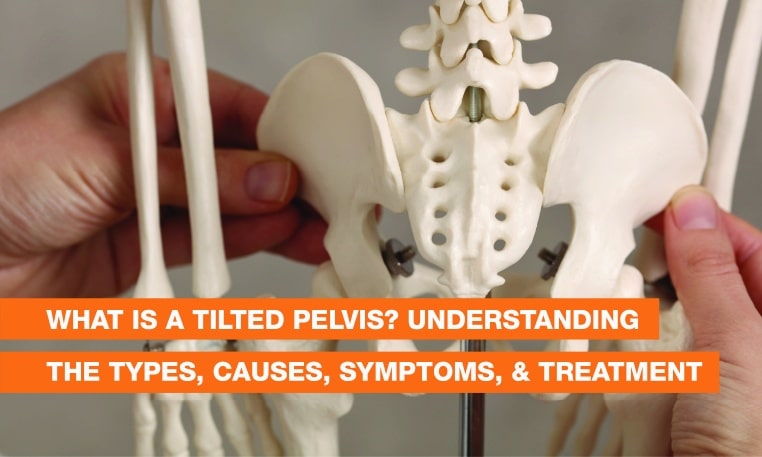What is a Tilted Pelvis? Understanding the Types, Causes, Symptoms, & Treatment
, 9 months ago
A tilted pelvis commonly causes pain in the lower part of the back, hips, and legs. This occurs due to improper alignment of the pelvis and uneven distribution of weight on the spine. It may cause an imbalance in the muscles and joints of the lower back, legs, and hips. It can also affect the normal posture and balance of the body. It may also interfere with daily living activities and increase the risk of injury. It may occur at any age. You can learn more about what is tilted pelvis in this article. If you experience constant
lower back pain, hips pain and legs pain, you must consult with an orthopaedic doctor for a proper diagnosis and treatment.
Different types of Pelvic Tilt
The pelvic tilt is of two main types:
- Anterior pelvic tilt
- Posterior pelvic tilt
- Anterior Pelvic Tilt: An anterior pelvic tilt occurs when the front part of the pelvis drops down and the back part rises. It causes an improper curve in the back. The improper curve in the back can help to diagnose the anterior pelvic tilt. Another important sign of anterior pelvic tilt is the protruding abdomen. The abdomen is protruded due to a tilted pelvis.
- Posterior Pelvic Tilt: In the posterior pelvic tilt, the back of the pelvis drops down, and the front rises up. This causes a flat back. It occurs due to lack of exercise, poor posture, and muscular imbalances. A posterior pelvic tilt can cause pain in the back, hips, and legs and difficulty in performing daily living activities. The flat back can be seen when a person is standing or lying down. It helps identify the posterior pelvic tilt.
Causes of the Tilted Pelvis
There may be different causes of tilted pelvis. Some important causes of the tilted pelvis are:
- Poor Posture: Sitting for a long time and a sedentary lifestyle can cause an anterior or posterior tilted pelvis due to muscle imbalances. The joints also get affected due to prolonged sitting.
- Muscular Imbalances: Muscle imbalances can cause a tilted pelvis. Tight hip flexor muscles and weak gluteus muscles can cause anterior pelvic tilt, and tight hamstrings and weak abdominal muscles can cause posterior pelvic tilt.
- Injuries: Injuries to the pelvic area can also cause a pelvic tilt.
- Lack of exercise: People who do not perform physical exercises and live a sedentary lifestyle can also suffer from a pelvic tilt. This can cause muscle imbalances.
- Genetics: Genes also play a role in causing a tilted pelvis. A discrepancy in leg length can cause the pelvis to tilt forward or backwards.
- Pregnancy: Pregnancy can also cause a shift in the pelvis. This may occur due to increased pressure on the uterus and weakness of pelvic muscles.
Symptoms of Tilted Pelvis
A tilted pelvis can cause numerous symptoms. Some of the common symptoms of tilted pelvis are:
- Pain in the lower back & pelvic region
- Difficulty in sitting in a comfortable position
- Pain in the flexor muscles and discomfort in the lower back and hips
- Difficulty in walking or improper balance
- Reduced physical activity
- Muscle imbalances
If you experience any of the above symptoms, you must consult with an orthopaedic doctor immediately for a proper diagnosis and treatment. Immediate diagnosis and treatment can help to reduce pain and restore proper alignment.
Treatment of Tilted Pelvis
Treatment of the tilted pelvis involves restoration of proper alignment of the pelvis. This will help in reducing pain and improving posture. Some steps, including the treatment of a tilted pelvis, are:
- Identification of the Type of Tilted Pelvis: It is important to identify the kind of tilted pelvis for proper treatment. Your healthcare physician will determine the type based on your posture and symptoms.
- Make Changes in Your Lifestyle: If you have a tilted pelvis, you can restore the normal tilt by making some lifestyle changes. You must avoid sitting for long periods, maintain a good posture while walking and standing, and wear supportive footwear.
Exercise for Tilted Pelvis
Exercise can help in the treatment of a tilted pelvis. You can meet a physiotherapist who can suggest the best exercises to alleviate pain and improve your posture. Some exercises for tilted pelvis are:
- Enhance the Strength of Core Muscles: Weakness of core muscles can cause a pelvic tilt. You can start exercises to improve the strength of core muscles, such as planks, crunches, and bridges. These exercises also help in improving pelvic alignment.
- Stretching of Hip Flexor Muscles: Doing exercises to improve the strength of hip flexor muscles can help to improve anterior pelvic tilt. You can practise kneeling, pelvic tilts, and lunges to stretch hip flexor muscles.
- Practise Neutral Position: This can help to maintain proper pelvic alignment. You can stand with your feet hip-width apart and tilt your pelvis forward and backwards to find a neutral position where you feel balanced. Your body weight should be balanced on both feet, and your shoulders should be relaxed.
- Physical Therapy: A physiotherapist can make a treatment plan depending on the type of tilt. Physical therapy can help to improve the muscle strength around your pelvis, can relieve tightness of the muscles, and can help to maintain a proper posture.
Conclusion
A pelvic tilt is a painful condition in which the symmetry of the pelvic region becomes imbalanced. It is of two types: anterior and posterior. Symptoms may vary depending on the type of the tilt. Pain in the muscle imbalances and lower back are the most common symptoms. Physical therapy, lifestyle changes, and routine exercise for tilted pelvis can help in reducing pain, improving muscle strength and correct posture. You must consult with the top orthopaedic doctor at
QI Spine Clinic for back pain and muscle imbalances for a quick and proper diagnosis and treatment.

